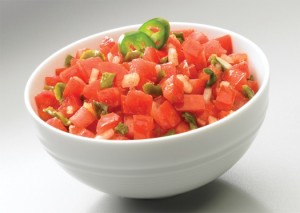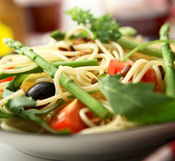November 11, 2015
June 4, 2012
Top 10 Tips For Staying Motivated With Your Workout Plan
- Vary your routine or change your scenery! A new variation on your favorite activity — cardio kickboxing instead of Step aerobics; power yogainstead of working on machines — may be enough to reinvigorate a stale routine. If you’ve always exercised indoors, move your workout outside for a welcome change of scenery.
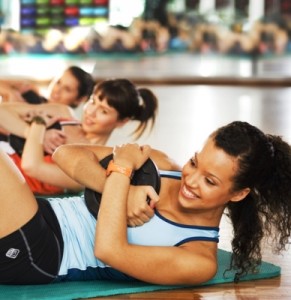
- Try something entirely new! Make it something you never dreamed you’d do. If you’ve always stuck to solitary pursuits, sign up for a team sport. Or tackle something you’ve shied away from… maybe even rock climbing!
- Find a workout buddy! Exercise companions add a social element to any routine. Ask a friend to be your workout partner — you won’t skip a workout if someone is waiting for you.
- Set a new goal! Working out to stay in shape is fine, but setting a goal — such as finishing a 10k race or completing a rough water swim — will give your daily workouts more meaning.
- Treat yourself to a workout gadget or accessory! Heart-rate monitors, aquatic toys and other exercise gadgets can make your workouts more fun and challenging.
- Keep an exercise log to track your progress! Unsure if your making progress toward your goals? Then start a workout log. It allows you to keep track of your goals, monitor your progress and adjust your routines as necessary.
- Don’t berate yourself if you miss a workout! Life is full of obstacles. Unexpected appointments, illness and setbacks are bound to happen sooner or later. Don’t let a few missed workouts turn into a month of unfulfilled resolutions.
- Reward yourself! Reaching a fitness goal or milestone is a great excuse to treat yourself to something new. A massage, an evening out, or some other “indulgence” may be the key to staying motivated.
- Focus on how good exercise makes you look and feel! You know that incredibly satisfied and healthy feeling you get immediately after a workout? Remember it! And use it to motivate yourself the next time you’re thinking about blowing off that next workout!
- If all else fails… take a break from exercise! Sometimes a lack of motivation is your body’s way of telling you to take a break. If anything hurts, or if your energy is running low, take a break for a few days before resuming your workouts. A little “R&R” may be just what your body needs to renew your motivation.
–
Source: Health Discovery
March 27, 2012
Fitness Tips: Curls for the well-armed
Curls for the well-armed
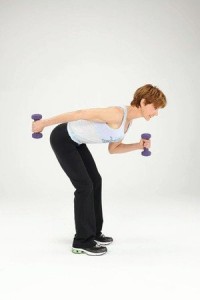
Use light weights in this exercise for a convenient, fast and effective way to work the fronts and backs of your arms at the same time. Remember to pull your abdominal muscles in to support your spine in this forward bend.
Stand with your feet about shoulder-width apart. Grasp a pair of 3- to 5-pound dumbbells, bend your knees slightly and lean forward so your torso is almost parallel to the floor. Keep your elbows next to the sides of your torso. Straighten your right arm behind you until your elbow is straight and next to your body. Simultaneously, bend your left arm to bring the dumbbell close to your left shoulder. Pause for 2 seconds in this position.
Repeat the same movement again, but this time straighten your left arm behind you and bend your right arm forward. Continue to alternate arms until you have completed 32 biceps curls and 32 triceps extensions with each arm. Focus on keeping your upper arms close to your torso as you perform this move. Stand up, rest for 15 seconds and repeat two more sets.
March 23, 2012
Low-Fat Beats Low-Carb For Heart Health
For people at risk for hypertension, reducing fat intake may be key to protecting the heart. According to a study published in the American Heart Association’s journal Hypertension, a low-fat diet is more effective than a low-carbohydrate diet in reducing the risk of developing hypertension, a precursor to cardiovascular problems such as atherosclerosis.
When the two types of diets were compared in apparently healthy participants, the low-fat diet was the winner at improving blood pressure markers, such as blood flow in the arteries. This led the researchers to conclude that low-fat diets “may confer greater cardiovascular protection” than low-carb diets.
—
source: IDEA Fitness
March 22, 2012
Hot Salsa Tip
Did you know that salsa has surpassed ketchup as America’s favorite condiment? Salsa can spice up all kinds of bland meals. Stir in a jar of your favorite salsa to add some zing to a pot of kidney, white, pinto, red or black beans; then top with a dollop of sour cream for a unique, high-fiber side dish.
March 20, 2012
Fuel Up!
Wow, this is great!
This one simple step alone will not only lengthen your workout, but it will also increase your performance, which is the key when training and exercising. That step? Fill ‘er up! If you don’t eat before exercise, you will likely feel light-headed, fatigue and nausea. Your body is then forced to turn to muscle protein for fuel because it doesn’t have enough carbohydrates to perform.
By starting your workout well-fueled, your body will burn a combination of the carbohydrates and stored fat. So fill ‘er up…and here are the food and beverage tips from your coach Max: Eat 1 hour before a workout or event. Choose a high carbohydrate, low fat, moderate protein meal or snack. And don’t forget to hydrate. Drink at least 10 ounces of water to help offset perspiration loss during your workout.
March 19, 2012
6 Fitness Tips to Follow While Traveling
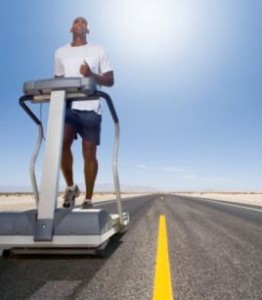 If on the whole you make the effort to eat healthy and have an effective exercise regime, you are likely to be concerned that any travel plans will derail this process. So here are some tips that will help you continue with your fitness programs even when you travel.
If on the whole you make the effort to eat healthy and have an effective exercise regime, you are likely to be concerned that any travel plans will derail this process. So here are some tips that will help you continue with your fitness programs even when you travel.
1. Do some homework before you leave. Check if the hotel that you plan to stay in has gym facilities or a pool and so on (depending upon your preferred workout activity).
2. Remember to pack workout clothes and shoes. This will remind you to work out and also make it convenient to hit the gym or simply head out for a walk wherever you are staying.
Workout shoes can be bulky so rather than carrying them in your baggage, you can simply wear them when you travel and instead pack the other less bulky shoes into your bag.
3. Carry a jump rope or a couple of dumbbells or kettle bells with you. A session with the jump rope can be a really strenuous workout in a short time, and doing a few weights with dumbbells or even lifting some bottles of bottled water can be a good workout.
4. Do other exercises that don’t need equipment – pushups, leg raises, squats, lunges and stair climbing are all easy to do wherever you are.
5. When eating out, order items that are steamed, grilled or poached. Avoid the items that are fried or calorie rich – if it says ‘crispy’ or ‘golden’, it’s probably been deep-fried, if it says ‘rich gravy or dressing’ that means high in calories too.
Also remember if it is a salad you’re ordering, ask for vinaigrette dressing rather than a cream or mayo-based one. Order small portions and opt for fruit instead of a confection at the end of the meal
—
Courtesy from FitnessHealthZone
June 1, 2011
Got culture?
Got culture? Museums, theaters and concert halls may be the ticket to a happy, healthy life

People who attended concerts, went to museums, and engaged in cultural activities in general were happier and healthier in a recent study. (Luis Sinco/Los Angeles Times)
The secret to a healthy, happy life may be found at an art gallery, movie theater or concert hall. (It might even be in church, a baseball stadium or gym.) At least if you live in Norway.
A study of more than 50,000 Norwegian men and women found that those involved in cultural activities — either “receptive” activities like attending a concert or a baseball game or “creative” ones like playing in a band or working out — were more likely to be satisfied with their lives and to say they were in good health. They were also less likely to experience anxiety or depression.
The particular activities that made a difference were a little different for men and women. For instance, women who attended sporting events were more likely to report being in “good” or “very good” health. For men, involvement with anyreceptive cultural activity, including visiting a museum or going to the theater, was linked with “good” or “very good” perceived health.
With regard to depression, both men and women had lower scores if they participated in clubs, outdoor activites or worked out. Women also had lower scores if they went dancing, and men also had lower scores if they were involved in music, singing or theater.
Generally speaking, the more people engaged in various cultural activities, the better their scores:
“In both women and men, a dose-response effect was indicated,” the researchers wrote. “The frequency of cultural particpation and the number of different activities were positively associated with good health, SWL (satisfaction with life), a lower anxiety score and a lower depression score.”
Of course, people who earn more money were more likely to take part in both receptive and creative cultural activities. And it’s well known that people with higher incomes are also more likely to be healthy. But the researchers found that a link between cultural partipation and health that was independent of socioeconomic status.
April 29, 2011
Interval training may help obese and overweight people slim down
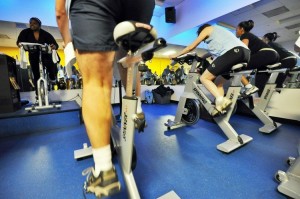
A group cycling class can offer high-intensity cardiovascular training. (Jewel Samad / AFP/Getty Images)
The one-two punch of high-intensity exercise and healthful eating was helpful in getting overweight and obese people to slim down, a study finds.
The study, presented this week at the National Obesity Summit in Montreal, Canada, focused on data on 62 overweight and obese men and women involved in a nine-month program at the Montreal Heart Institute. The participants engaged in two to three weekly one-hour supervised exercise sessions and were instructed on how to follow a Mediterranean diet.
The exercise sessions concentrated on high-interval training, or alternating between short periods of vigorous workouts and rest periods. Interval training has been shown in some studies to promote weight loss as it boosts cardiovascular health. Participants had a five-minute warm-up followed by repeated bouts of exercise at 80% of peak effort. Those were interspersed with brief recovery periods, and the workout finished with a five-minute cool-down. In addition, the study subjects did a 20-minute weight training circuit and were encouraged to do one or two moderate 45-minute exercise sessions a week.
At the end of the study, the men and women on average lost 5.5% of their body mass, reduced waist circumference by 5.15% and increased cardiovascular capacity by 15%. They also had an average 7% decrease in LDL (bad) cholesterol and an 8% increase in HDL (good) cholesterol.
In the study the authors concluded that the supervised twice-weekly interval training program “appeared feasible, safe and time-efficient in this obese population.”
April 12, 2011
Does Dieting Make You Angry And Stressed?
 The idea of reaching for a stick of celery when all you really want is a big slice of chocolate cake, would probably make most people a little grumpy.
The idea of reaching for a stick of celery when all you really want is a big slice of chocolate cake, would probably make most people a little grumpy.
And, according to results published in the Journal of Consumer Research, exerting self-control while dieting can in fact make people feel angry and irritable.
The researchers set up four experiments to compare the attitudes of volunteers who were on a diet, with those who ate what they wanted. They found that:
- Participants who choose an apple over a bar of chocolate were more likely to choose movies which had angry, revenge-filled plots.
- Those who choose a gift certificate for groceries rather than one for a spa service, showed more interest in looking at angry faces as opposed to more fearful ones.
- And, in an other experiment, people who chose a healthy snack instead of a less healthy one were more irritated by a public service advert promoting exercise.
Interestingly, the researchers have linked these feelings of irritation, stress, and anger to the act of exerting self-control while dieting, rather than the “dieting” itself.
The researchers point out that public policy makers should be more aware of the potential negative emotions, which can result when the public are encouraged to exert more self control over their daily choices.
What about you — does being on a diet make you feel more irritated or angry? How do you make healthy food choices without feeling like you’re denying yourself?
—
Article Courtesy from: diet-blog
Image courtesy by: Kreutziana

